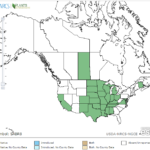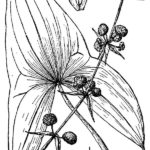Sagittaria brevirostra
USDA, NRCS. 2018. The PLANTS Database (http://plants.usda.gov, 28 March 2018). National Plant Data Team, Greensboro, NC 27401-4901 USA.
Illustration: USDA-NRCS PLANTS Database / Britton, N.L., and A. Brown. 1913. An illustrated flora of the northern United States, Canada and the British Possessions. 3 vols. Charles Scribner’s Sons, New York. Vol. 1: 100.
What is Shortbeak Arrowhead?
Other common spellings and names include: Midwestern arrowhead.
Physical Characteristics
Leaves:
- Straight
- Egg- or sword-shaped leaf blades
- Arrowhead shaped
- Portion above the base lobes up to 8 inches long & wide
Flowers:
- Bracts firm & sword-shaped
- Densely covered in bristles or spines
- Up to 0.78 inches in diameter
- Blooms Jul – Aug
Fruit:
- One seeded
- Does not open to release seed when ripe
- Up to 0.13 inches long & 0.08 inches wide
Stem:
Where Does it Grow?
Shortbeak arrowhead can be found along rivers, ditches and swamps.
Pros and Cons of Arrowhead
The tubers of arrowheads are prized foods by ducks, geese, muskrats, and nutria. Seeds are sometimes consumed by ducks. Submerged portions of all aquatic plants provide habitats for many micro and macro invertebrates. These invertebrates in turn are used as food by fish and other wildlife species (e.g. amphibians, reptiles, ducks, etc.). After aquatic plants die, their decomposition by bacteria and fungi provides food (called “detritus”) for many aquatic invertebrates.


